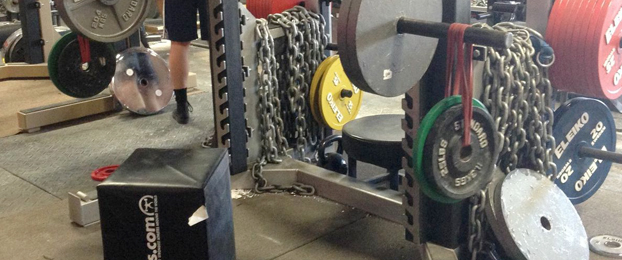
Initially used for accommodating resistance, chains help take into account the body’s natural strength curve. Many people have become familiar with this concept over the last few years as chains have become increasingly popular. People also like the “blue collar” attitude that chains portray. However, chains can serve a much greater purpose with a little creativity in the gym.
Accommodating resistance
The primary function of chains is to accommodate resistance. I first saw chains being used by Louie Simmons in some older Westside Barbell videos. The concept is simple. Your body is weakest at certain points during a movement. If lifters can figure out a way to lessen the weight during the weak portions and increase the weight during the strong portions, they will get more out of the lift.
Let’s take the squat as an example. The lower that a lifter descends in a squat, the tougher the squat gets because the lifter’s body loses some of its mechanical advantage. As the lifter rises, the squat gets easier. Think about all the people who you’ve seen quarter squatting a lot of weight. Many of them wouldn’t stand a chance at doing a full squat because they’re avoiding the toughest portion of the lift.
For accommodating resistance, ⅝-inch or ½-inch chains usually come with a thin guiding chain. The guide chain is looped around the bar and adjusted to the bar. The rest of the chains are then clipped to the small chain using a carabiner. The large chain should be adjusted so that when the lifter stands upright, some of the links are still on the ground and the weight isn’t swinging around.
As the lifter squats down, the chains should pile up on the floor, making the weight lighter at the bottom portion of the lift. When the lifter begins to rise, the chains come off the floor, making the weight heavier. So as the lifter gets to the tougher portion of the lift, the weight is lighter. As the lifter rises up and gains a mechanical advantage, the weight gets heavier.
We have had great success using chains for this purpose, primarily on the bench, squat, and deadlift. All of our athletes have seen gains from the increased stress during the full range of motion. I highly recommend that advanced lifters incorporate chains for this purpose.
Weight loading
Chains are also a great substitute for weighted vests. Clip the chain ends together to create a loop. Slide one over each shoulder and across your body to form an “X.” Many people refer to this as “Chain Xing” or “Rambo style” (picture the gun clip belts worn in the movie). Also, for A Christmas Carol fans, you could refer to it as the “Jacob Marley.” (But seriously, I wouldn’t!)
Image caption: Weighted walking dips
Unstable training
Chains are also great for working the stabilizers. Instead of having the chains drag on the floor, suspend them so that they are in the air. This isn’t for max effort lifts, but it’s good for repetition work. Possibilities include suspended chain curls, chain clean and press, suspended chain split squats, step-ups, and more. Nearly everywhere a straight bar or handle is used, suspended chains can be substituted.
Chain farmer’s walk
What is the weak link of the farmer’s walk? Typically, it’s the grip. To tax the body and grip more equally, attach chains to a stirrup handle so that there are still links on the ground. Perform the walk while the chains drag behind. The friction with the ground will create a great deal of resistance. The pressure on your grip will be relative to how fast you walk. Think of it as a chain farmer’s walk and dragging combination. It creates the tension of a farmer’s walk and a sled drag simultaneously.
Try to be creative and use the chains to address specific weaknesses and facets of strength. When using unstable chains, start light and concentrate on keeping your body tight when performing each exercise. Chains are a good instrument for your training tool box. Work them in to your program and reap the benefits!








